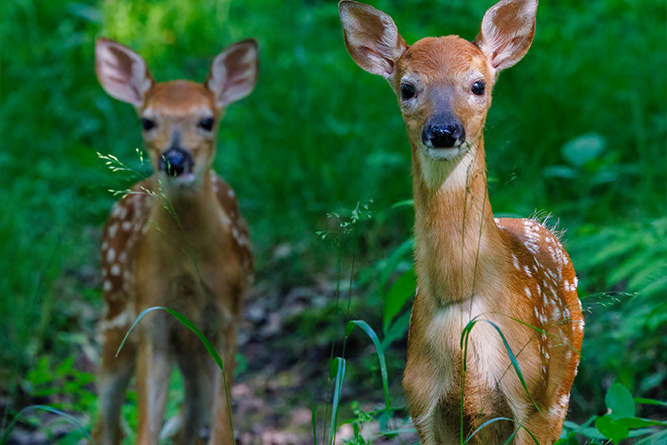White-tailed deer, with their distinctive long tails and graceful leaps, are a captivating sight in North America’s woodlands. These enchanting creatures hold several intriguing secrets that make them stand out among the animal kingdom. Let’s uncover some remarkable facts about these iconic deer.
Table of Contents
SPECIES DATA
- Class: Mammalia
- Order: Artiodactyla
- Family: Cervidae
- Scientific Name: Odocoileus virginianus
- Life Span: 6-14 years
- Height: 70-94 cm
- Weight: 100-300 pounds (45-136 kg)
Description
White-tailed deer are medium-sized herbivores characterized by their reddish-brown coat and a signature fluffy, white tail. They possess slender bodies and elegant, branching antlers (present in males) that grow throughout their lives.
Appearance
These deer have a striking appearance with their large, expressive eyes and a white underside on their tails. Their fur helps them blend seamlessly into their forest habitats, offering them camouflage from predators.
Behavior
White-tailed deer are typically crepuscular, meaning they are most active during dawn and dusk. They are skilled swimmers and runners, often escaping predators with their remarkable speed and agility.
Habitat
What is the white tailed deer habitat? White-tailed deer can be found in a variety of habitats, including forests, grasslands, and wetlands, across North and Central America.
Diet and Nutrition
What do white tailed deers eat? Their diet mainly consists of plants, including leaves, twigs, fruits, and grasses, making them herbivores. They play a crucial role in shaping the ecosystems they inhabit through their feeding habits.
Mating Habits
White-tailed deer breed during the fall, with males competing for the attention of females. Females, known as does, give birth to one to three fawns in the spring.
MATING BEHAVIOR
- Reproduction Season: Fall
- Pregnancy Duration: Approximately 200 days
- Baby Carrying: Does carry their fawns in their womb.
- Independent Age: Fawns become independent at around 2-4 months.
- Female Name: Doe
- Male Name: Buck
- Baby Name: Fawn
5 Fun Facts for Kids about White-tailed Deer
- White-tailed deer can jump as high as 10 feet in a single bound.
- Fawns are born with white spots on their fur, helping them blend into their surroundings.
- They have a keen sense of smell, which helps them detect predators.
- White-tailed deer communicate using a variety of vocalizations, like grunts and bleats.
- Antlers are unique to the males, and they shed and regrow them annually.


